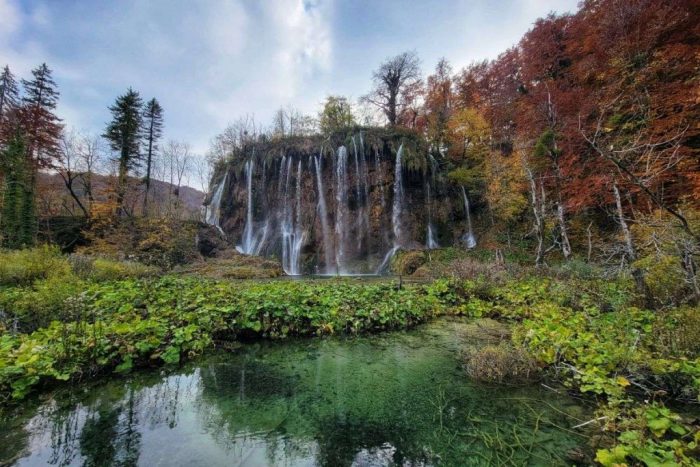Experience the Lifechanging Adventure of Gorilla Trekking in Africa (Yes, It’s Safe and Ethical!)
If you’re a wildlife lover heartbroken by the unethical practices in most animal tourism industries, a mountain gorilla trek in Africa is totally up your alley. Skip the zoo and take a guided venture through untouched forests to witness gorilla groups thriving in their remote, natural habitat.
Your experience will be totally unique — rangers choose trails based on your physical abilities. Prep for rugged terrain, though!
Best of all, these protected areas play a huge role in gorilla conservation. Cue the happy tears! Grab the Kleenex and get ready for a life changing experience on your African mountain gorilla safari.
What is gorilla trekking?
Ready for an immersive wildlife experience the way it should be felt: with your whole dang soul? Then it’s time to go gorilla trekking in an African national park.
Unlike so many animal tourist activities, gorilla trekking was actually founded on animal conservation. After a tragic period in the 1970s where six gorillas were killed, including a silverback in Volcanoes National Park, gorilla watching was born out of a dire need. Though it took some time to perfect (after all, it’s not every day you start introducing humans to gorillas in the wild), gorilla tourism now helps both endangered species and local communities thrive.
Want to know more? We recommend grabbing this book:

Because mountain gorilla trekking funds are reinvested in their parks, these powerful excursions support environmental protections, anti-poaching efforts, and local economic growth. And we all know that coming face to face with a mighty silverback will leave you spreading the message of gorilla conservation at every chance you get. No one’s heartstrings go untouched on a gorilla trek.
Of course, all these benefits only exist when gorilla watching is done responsibly. This means only booking with a reputable tour operator that solely visits habituated groups, following the rules and regulations, and canceling the tour if you’re sick.
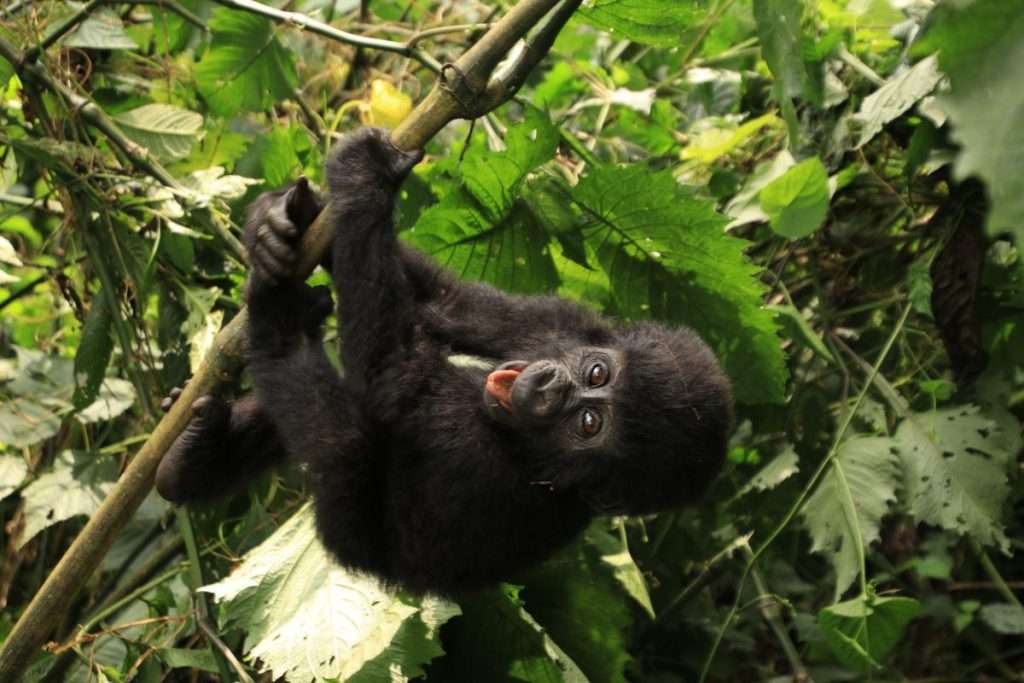
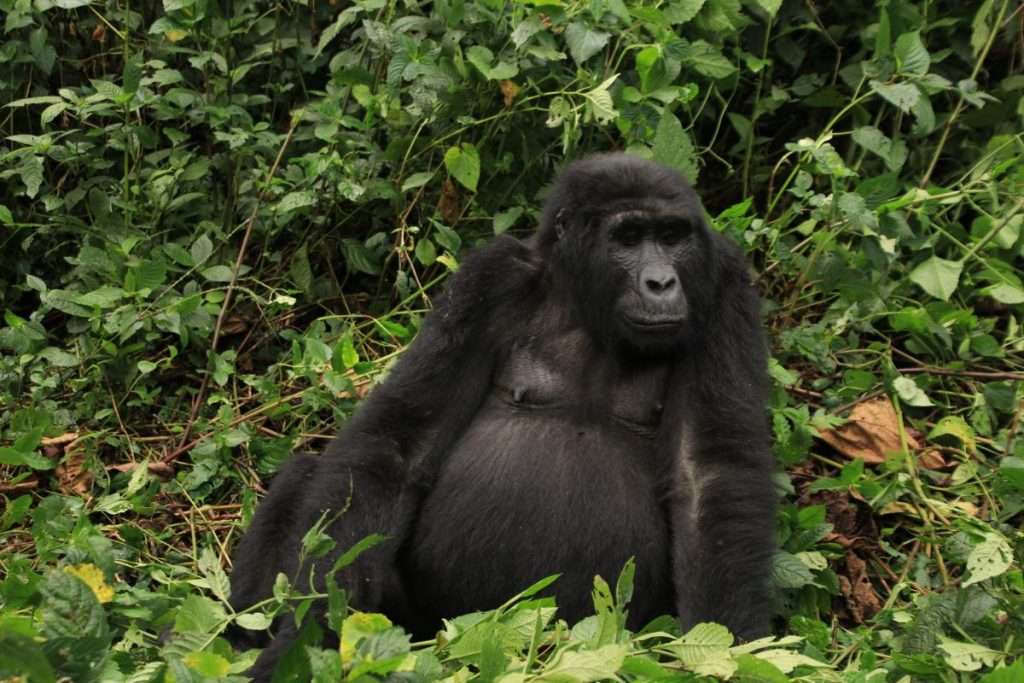
The best places in Africa for gorilla trekking
There are only a handful of places to hang with endangered mountain gorillas in Africa —and the world! — so, if you’re heading to Uganda, Rwanda, or the Democratic Republic of Congo, gorilla parks are a must-do. Just over 1,000 mountain gorillas survive today exclusively in Bwindi Impenetrable National Park and the Virunga Massif that stretches across the three countries. So add these parks to your itinerary, and prepare for your life changing gorilla safari.
- Bwindi Impenetrable National Park, Uganda. A UNESCO World Heritage Site and gorilla tracking destination? Yes, please! With over 35 mountain gorilla families and 15 habituated family groups across nearly 125 square miles, Bwindi National Park is a clear winner for eastern gorilla trekking holidays.
- Mgahinga Gorilla National Park, Uganda. Uganda’s small Mgahinga National Park was founded on conservation and was created to protect the region’s endangered wild gorillas. Now, you can spot one unhabituated and two habituated family groups, plus golden monkeys!
- Volcanoes National Park, Rwanda. Thanks to incredible conservation efforts in Volcanoes National Park, populations are growing in Rwanda’s only gorilla tracking park. Support ongoing gorilla protection by visiting Rwanda’s Volcanoes National Park.
- Virunga National Park, Democratic Republic of Congo. A third of the world’s endangered mountain gorilla population lives in the dense forest of the Virunga Mountains, making this park a prime spot for gorilla safaris. Keep an eye out for the unique tree climbing lions in this UNESCO World Heritage Site
- Kidepo Valley National Park, Uganda. Tucked into the northeast corner of Uganda, the Kidepo Valley is an untouched oasis home to over 500 animal species, some of which can’t be found elsewhere in the world. While you won’t find any gorillas here, this Wildlife Conservation Society zone is a must-see stop as you explore East Africa.
The habitat of the gorillas
It’s no surprise that mountain gorillas live in bamboo forested, high-altitude, mountainous regions. Their insulating coats keep them toasty in the sometimes freezing climate of their 8,000′ to 13,000′ elevation homes.
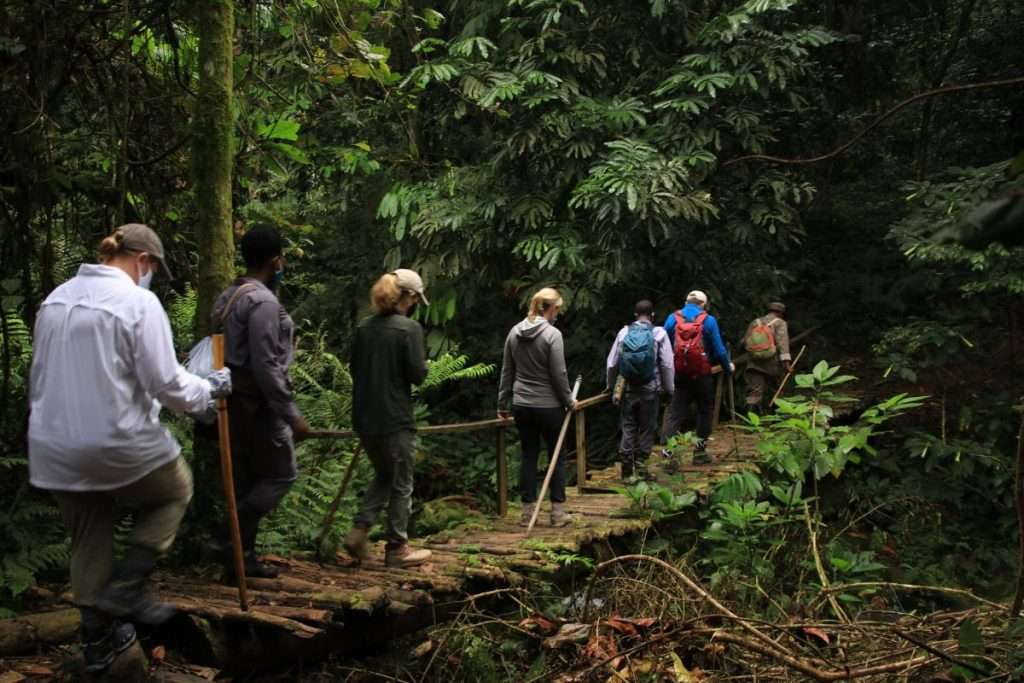

These nomadic primates build new nests daily and can migrate throughout the protected parks they call home. That’s partially why gorillas in the wild have become so threatened: human development can force them to move to higher elevations unsuitable for the groups.
Gorillas in Africa also wander into nearby farmland to snack on bananas, corn, and other crops.
The best time to go gorilla watching
Make it your New Year’s resolution to go gorilla tracking, then cross it off ASAP by booking in January or February. It’s low season for tourism, but the rainy months haven’t hit yet.
June to August is considered the best time for gorilla treks in Uganda and Rwanda. But head’s up: it’s busy season! You’ll enjoy dry, hot days and cool evenings — just snag that gorilla permit ASAP.
Gorilla permits are easier to snag in the rainy seasons of March through May and September to November. Your gorilla trek (and road travel) will be more difficult at this time, thanks to the wet trails, but if you can get down with the rain, you’re way more likely to glimpse other local wildlife species. cue heart melting.
Since Mgahinga is easily accessed by air, wet months are a great time to go. Plus, Uganda offers discounted gorilla permits in the low season!

How to get gorilla trekking permits
Not gonna lie: reserving your gorilla permit is basically an Olympic sport. They sell out months in advance, so it’s one of the first things to cross off your pre-Africa to-do list. (I see you, procrastinators.) Each one allows you to spend one hour with the mountain gorillas and includes the park entrance fee. FYI: your gorilla permit is only valid for a specific date and location, so no last-min itinerary changes!
- Mgahinga National Park, Uganda. Uganda Wildlife Authority. Hit up the Uganda Wildlife Authority via phone or email, or choose to book with an Association of Uganda Tour Operators (AUTO) approved organization. The park’s gorilla permits go for $700 each (for foreign non-residents).
- Bwindi Impenetrable National Park, Uganda. Uganda Wildlife Authority. Snag your $700 Bwindi Impenetrable Forest gorilla permits from the UWA or AUTO. Or, join some amazing, wildlife-loving women on Explorer Chick’s Uganda gorilla trekking experience, and we’ll take care of the permit for ya!
- Volcanoes National Park, Rwanda. Irembo. Tourists can grab one of Volcanoes National Park’s 96 daily gorilla permits for $1500 each through the Irembo platform. Double-check your application — incomplete or incorrect info can make your permit invalid.
- Virunga National Park, Democratic Republic of Congo. Visit Virunga. Every Virunga package in the Democratic Republic of Congo includes accommodations, meals, and all the park permits you need — including gorilla ones! Book directly from the Virunga National Park website.
Questions you want answers for
Of course, you have questions about gorilla tracking. It’s not every day that you fly to a national park in Africa to spend an hour with great apes in their natural environment. So let’s get your FAQs answered.
Will I actually see mountain gorillas?
Heck yeah, you will! Park rangers are basically gorilla whisperers. They do an impressive job tracking gorillas, so they know exactly where to find ’em when you show up for your safari. Once your gorilla tour finds the family groups, you’ll get an entire hour with the gentle giants.
How long does it take to find the gorillas?
Park rangers track gorillas overnight, so they know where to locate them in the morning, but the mountain gorilla safari to that spot can take up to 5 hours. Don’t worry about your legs, though — the actual walk to the family can take as little as half an hour. It totally depends!
Is it safe to be close to mountain gorillas?
Yes and no. Although you will be seeing these gentle giants up close on your gorilla safari, you’ll still have to maintain about a 25′ distance. This distancing is primarily to avoid spreading illness between each other, but always remember that even habituated groups (AKA ones familiar with humans) are still mighty. Risk factors are inherent to any adventure excursion. That’s why rules exist!




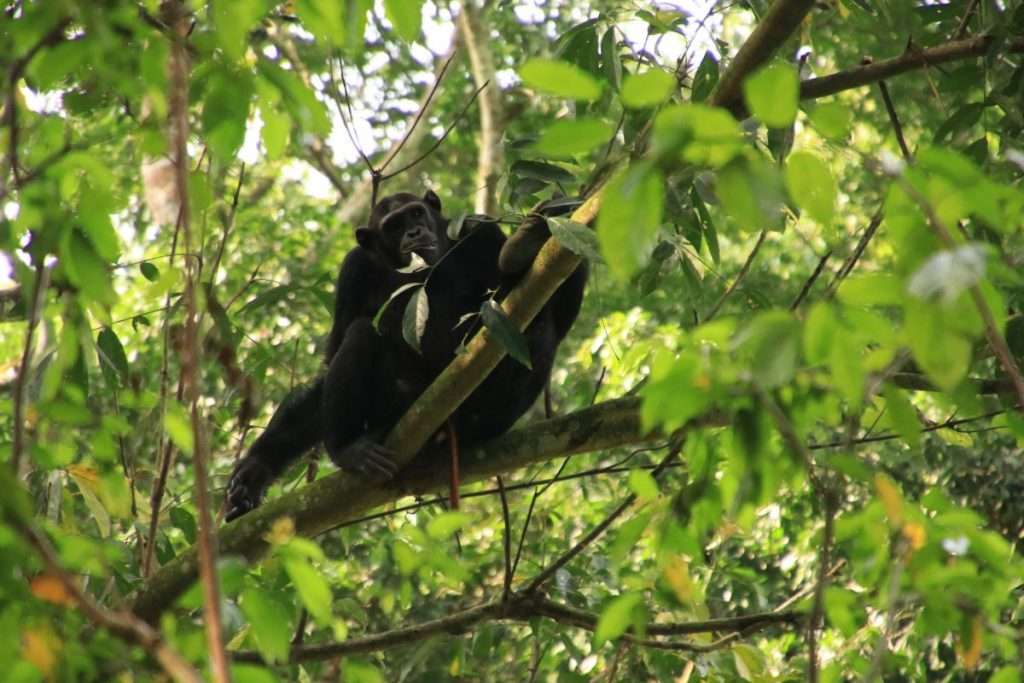

Can I take photos of the gorillas?
Feel free to snap that Insta pic to flex your gorilla safari adventure, but try not to spend too much time behind your phone. Appreciate the moment! You only have an hour with the gorilla families, and it’s one you’ll dream about for the rest of your life (seriously). So remember that no image will do justice to what you’re seeing IRL, but a few photos are all good. Just turn off the flash first!
Rules for gorilla trekking
Spotting gorillas in the wild means entering their natural habitat, which shouldn’t be taken lightly — even within a park boundary. Certain rules are necessary for gorilla tourism to keep you and the animals safe. After all, Eastern gorillas are an endangered species and need all the protection they can get!
- Keep your distance. Since humans and mountain gorillas are so alike (we share 98% of the same DNA!), illnesses can quickly spread between our species. Remember those physical distancing skills and stay about 25 feet apart.
- Respect the animals. Even habituated gorillas are timid around people and can misinterpret your awe as a threat. Avoid prolonged eye contact, loud noises, and visible excitement around wild gorillas, and resist that tempting urge to touch them.
- Cancel if you’re sick. As heartbreaking as it is, you’ll need to cancel your trek if you’re unwell. Already facing extinction, gorilla populations are incredibly vulnerable to disease transmission and don’t need any more threats!
- Stay with the group. Wandering off on a gorilla trekking safari is a big no-no. Always remain close to your guide so you don’t get lost, panic, or have unwanted run-ins with an animal.
- Listen to your guides. Expert tour operators — and armed park rangers, if you’re in Rwanda or the DCR — guide you through your gorilla watching journey. These pros know exactly how to keep you (and the gorilla group) safe, so always follow their directions.
How to prepare for gorilla watching
It’s never too early to start prepping for your gorilla tour! First things first, secure your permit 3 to 6 months in advance, then get your body moving. Start building your endurance and power, then practice using your hiking poles on local trails if you can. And get those shoes broken in! You might also want to consider spending a few days in your destination before your trek to get used to the elevation difference.
Uganda gorilla trekking pack list
Mountain gorilla trekking isn’t an extreme sport, but packing the right gear will make this adventure a lot more enjoyable for you. Toss these items in your bag so you can focus on the adoooorable baby gorillas in front of you, not on your wet socks and hangry belly.
- Lightweight hiking poles (1 set). Keep your balance steady on those national park paths by carrying walking poles. You’ll definitely want these if you’re newer to trekking steep slopes, especially during the rainy season.
- Long, neutral-colored clothing (1 outfit). Long pants and shirts keep you warm and scratch-free while exploring overgrown trails. Choose neutral tones to avoid attracting unwanted animal attention!
- Hiking boots (1 pair). Mountain gorilla trekking isn’t a walk in the park (okay, technically it is…). It’s hard work! You’ll be hiking to and from the gorilla family for a few hours, so great (broken-in) hiking boots are a must.
- Knee-high gaiters (1 pair). Protect your feet and legs from the elements by rockin’ a pair of knee-high gaiters while venturing through the dense landscape towards those relaxed gorillas. We like these Outdoor Research gaitors.
- Snacks. Gorilla safaris can be lengthy activities, not to mention the hiking portion. So pack some energizing snacks to prevent hanger during gorilla tracking.
Ready to Get Trekking?
Join a chorus of “OMGs” and tearful “awwws” by booking your Uganda gorilla trekking experience with a group of animal-loving, adventure-driven Explorer Chicks. You and 11 other women will spend ten days soaking in spectacular sights and gush over your truly life changing memories for years to come. Reserve your spot today!
Meet the Writer


Megan Wray
Megan Wray is a queer, mixed-race Japanese-Canadian freelance writer based on Treaty 1 Territory. Passionate about pleasure, identity, and anti-oppression, Megan’s fuelled by meaningful chats about topics that aren’t “appropriate” for dinner table conversation. When she’s not writing, you can find Megan cooking vegan food, singing to live music, and trying to understand astrology.
More About Our Favorite International Destinations
- 7 Hot Springs in Uganda That You HAVE to Visit
- Best Castles of Scotland: Must-See Enchanting Castles
- 60th birthday trip ideas for mom
- What You Need To Know Before You Hike Rainbow Mountain Peru
- The Best Cycling Destinations in Croatia
- Best solo trips for women who love adventure
- Your Complete Itinerary of Things to Do in Jordan: An Adventurer’s Guide
- Iceland Insights: Where To See Puffins
- How to Symbolically Adopt a Gorilla to Support Wildlife Conservation


